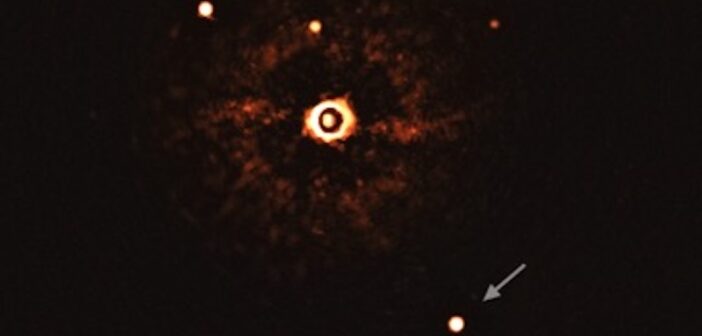Given JWST’s unprecedented capabilities, the first time it tries out a new instrument setting, it often sees something never before observed. Recently, that trend continued when JWST deployed its coronagraphic masks and snapped the first direct picture of an exoplanet in the mid-infrared.
New Settings
As has been noted repeatedly in AAS publications, JWST is a telescope like no other. For more than a year, scientists and the public alike have been spoiled with nearly weekly discoveries enabled by its unparalleled sensitivity. In exoplanet science especially, it has made good on its promise to revolutionize the field. Now, as JWST becomes a toddler and celebrates almost 20 months in space, astronomers are finishing up analyzing the last of its initial studies with each instrument and setting.
One of these studies, led by Aarynn L. Carter (University of California, Santa Cruz), describes JWST’s first attempts at high-resolution direct imaging of an exoplanet using its coronagraphic masks.
A Challenge, Even for the Best
Directly imaging an exoplanet is not an easy task: even planets that circle their host stars on wide, 100+ au orbits appear right next to them from our faraway vantage within the solar system. Additionally, planets are also much smaller, cooler, and therefore fainter than their hosts. Putting these two issues together, finding exoplanets by direct imaging is often compared to trying to see a firefly next to a floodlight from miles away.

Initial (leftmost column) and fully processed (right columns) images of HIP 65426b. Each row shows the planet through a different wavelength filter, and each column shows the result of a different processing technique. [Carter et al. 2023]
Even still, these masks cannot perfectly block out all of a star’s light, so image processing must be carried out back on the ground to cleanly extract any shy, small planets.
Impressive Performance
So how did JWST do? Even better than its high expectations. Although its target, a super-Jupiter named HIP 65426b, is more than 1,000 times fainter than the very nearby parent star, JWST could easily disentangle the two in all seven filters the team observed through. Some of those filters only let through mid-infrared wavelengths of light, making this the first direct picture of an exoplanet taken beyond 5 microns (1 micron = 10-6 meter).

Properties of HIP 65426b calculated by comparing JWST observations to evolutionary models. Click to enlarge. [Carter et al. 2023]
Planets this small and this close to their stars have never before been directly imaged. The fact that the next few years could include pictures of exoplanets similar to those in our solar system is a thrilling and surprising possibility, one brought about directly through the work that went into designing, building, and operating this miracle of a telescope.
Citation
“The JWST Early Release Science Program for Direct Observations of Exoplanetary Systems I: High-contrast Imaging of the Exoplanet HIP 65426 b from 2 to 16 μm,” Aarynn L. Carter et al 2023 ApJL 951 L20. doi:10.3847/2041-8213/acd93e

